Can I Keep A Catfish In A 6.5 Gallon Tank
There are many different types of catfish available in the aquarium trade, some of which work well in the home community aquarium and some of which definitely don't.
At that place'southward a catfish for all tank sizes and community types, so keep reading for a list of 8 catfish ranging from small-scale to medium sized and from calm to absolutely hyperactive!
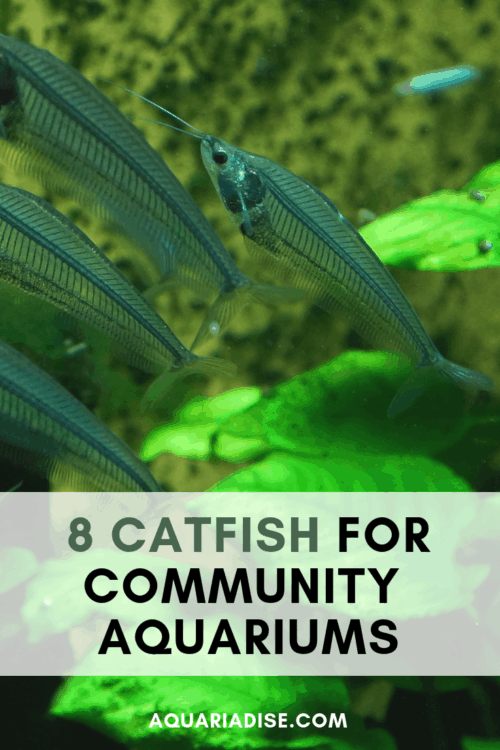
Cory catfish (Corydoras)
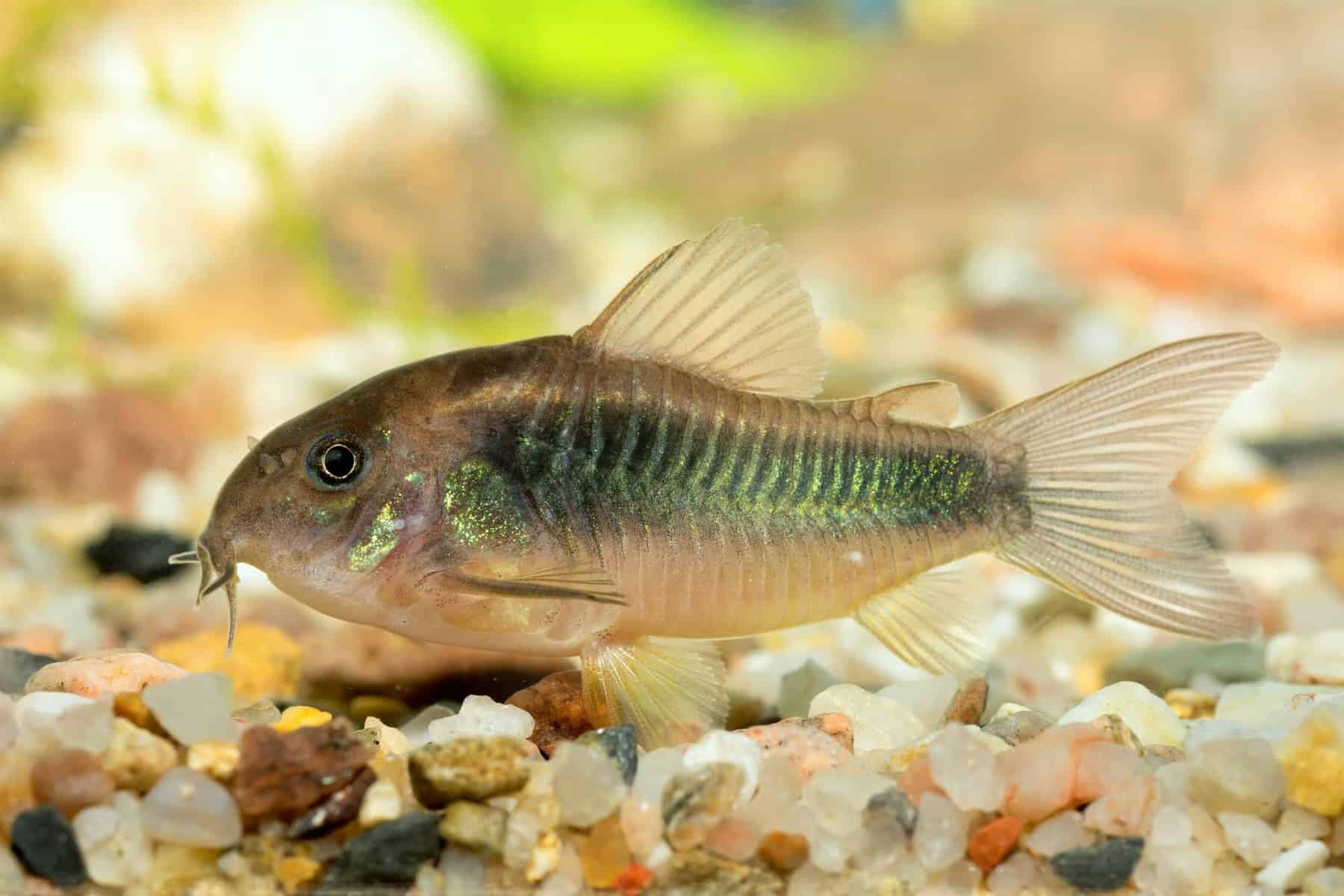
Probably the most well-known and popular type of aquarium catfish is the genus Corydoras, collectively known equally Cory catfish or Cories. At that place are many different Corydoras species, ranging from the tiny pygmy Cory which is suitable for tanks of 40cm/15.five″ and upwardly to larger species similar the bronze Cory, which needs 35.5″/90cm or more than.
All Corydoras are schooling fish and should exist kept in groups of at least five (preferably much more) to prevent stress and shyness. They are bottom feeders that love to sift around the bottom of their tank using their sensitive barbels. This means a sand substrate or small rounded gravel is recommended if you want to come across them show their natural foraging behavior and prevent barbel damage. Soft, relatively acidic water is preferred. When information technology comes to tankmates endeavor to choose peaceful species that prefer like water values. This list contains some options.
A full pygmy Cory (Corydoras pygmaeus, hastatus and habrosus) caresheet tin be found here while a full statuary Cory (Corydoras aeneus) caresheet tin can be constitute here.
And last but not least… don't forget to have a expect at the full article nearly Corydoras catfish including general info and a list of 5 fascinating members of the Corydoras genus here.
Upside-down catfish (Synodontis nigriventris)
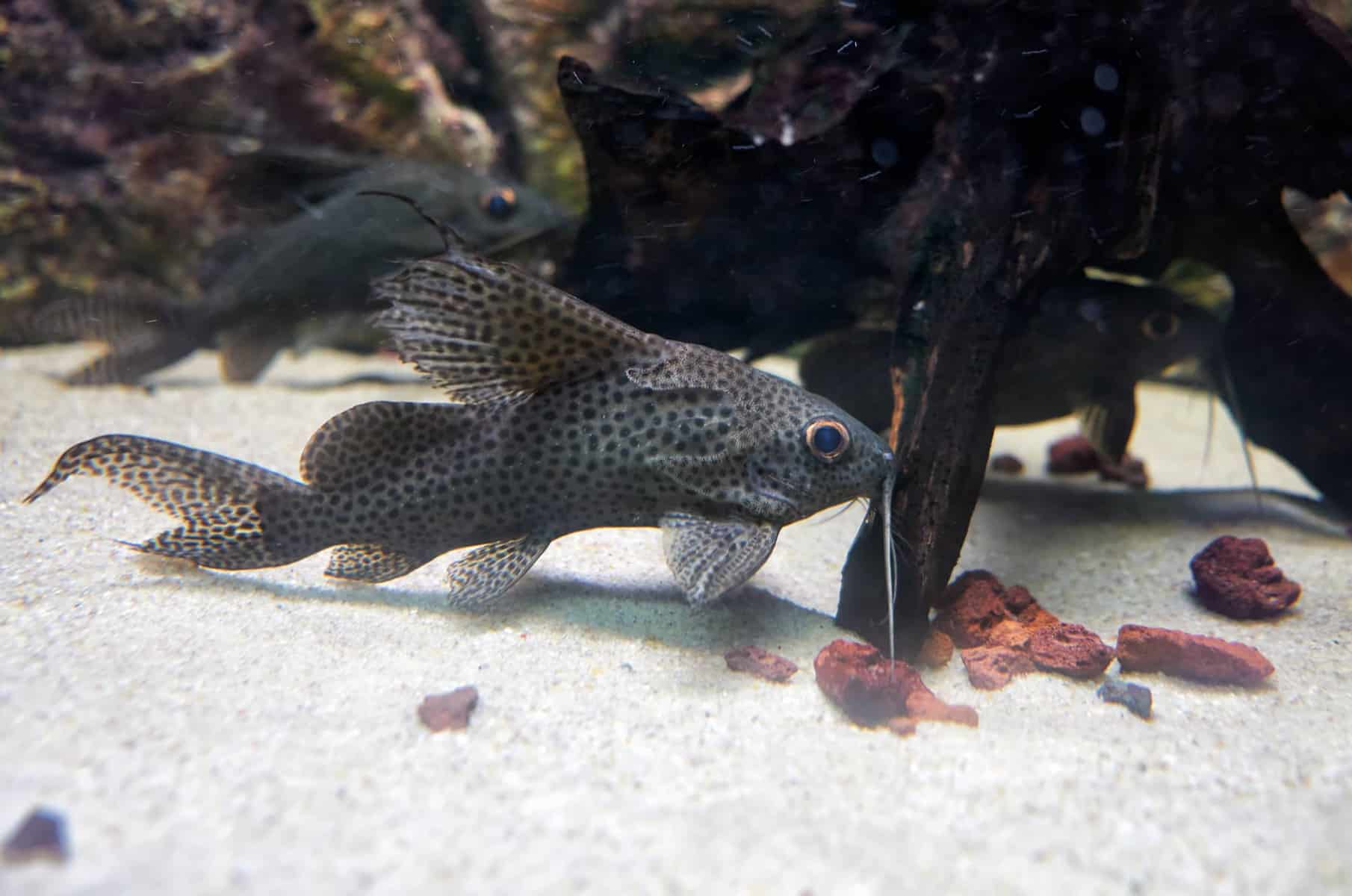
To the surprise of many non-fishkeepers and beginners in the hobby, the upside-down catfish (pictured at the pinnacle of this article) does exactly what its proper noun suggests. It swims upside-down!
One of the smaller and more peaceful members of its genus, the upside down-catfish is suitable for aquariums of at least 31.five″/80cm and does well in most moderately peaceful communities. This catfish is a pop choice for Central-/West-African biotope setups, so minor cichlids from similar areas (similar Kribensis cichlids) could make suitable tankmates.
Proceed groups of at least four upside-downwards catfish and be sure to provide enough of hiding places to prevent stress. Tall plants like Amazon sword should work well for this. Feed a combination of frozen, live and pellet foods.
Twig catfish (Farlowella acus, Farlowella vittata)
When information technology comes to odd looks, twig catfish from the Farlowella genus definitely take the cake. This species has taken camouflage to the next level by evolving to resemble a branch or twig. Definitely quite effective: in an aquarium with plenty of leaf litter you might not see a Farlowella until information technology moves.
Aquarists capeesh Farlowellas not just for their fascinating looks, but also for their peaceful beliefs and big appetite for algae. In fact, the species is on the list of best algae eatersandthe list of perfect peaceful community fish!
If you'd similar to keep a Farlowella in your ain aquarium, remember that these catfish don't respond well to bad water quality. They grow to an adult size of around six″ or 15cm, which means yous'll need an aquarium of at to the lowest degree around 35.5″ or 90cm to house a single specimen.
To keep your Farlowella happy and healthy, consider cultivating some algae in a carve up tank. Additionally, feed plenty of other greens to forbid the fish from going hungry. Algae tabs brand a expert staple and you can use greens like zucchini or kale for some actress variation.
Otocinclus catfish
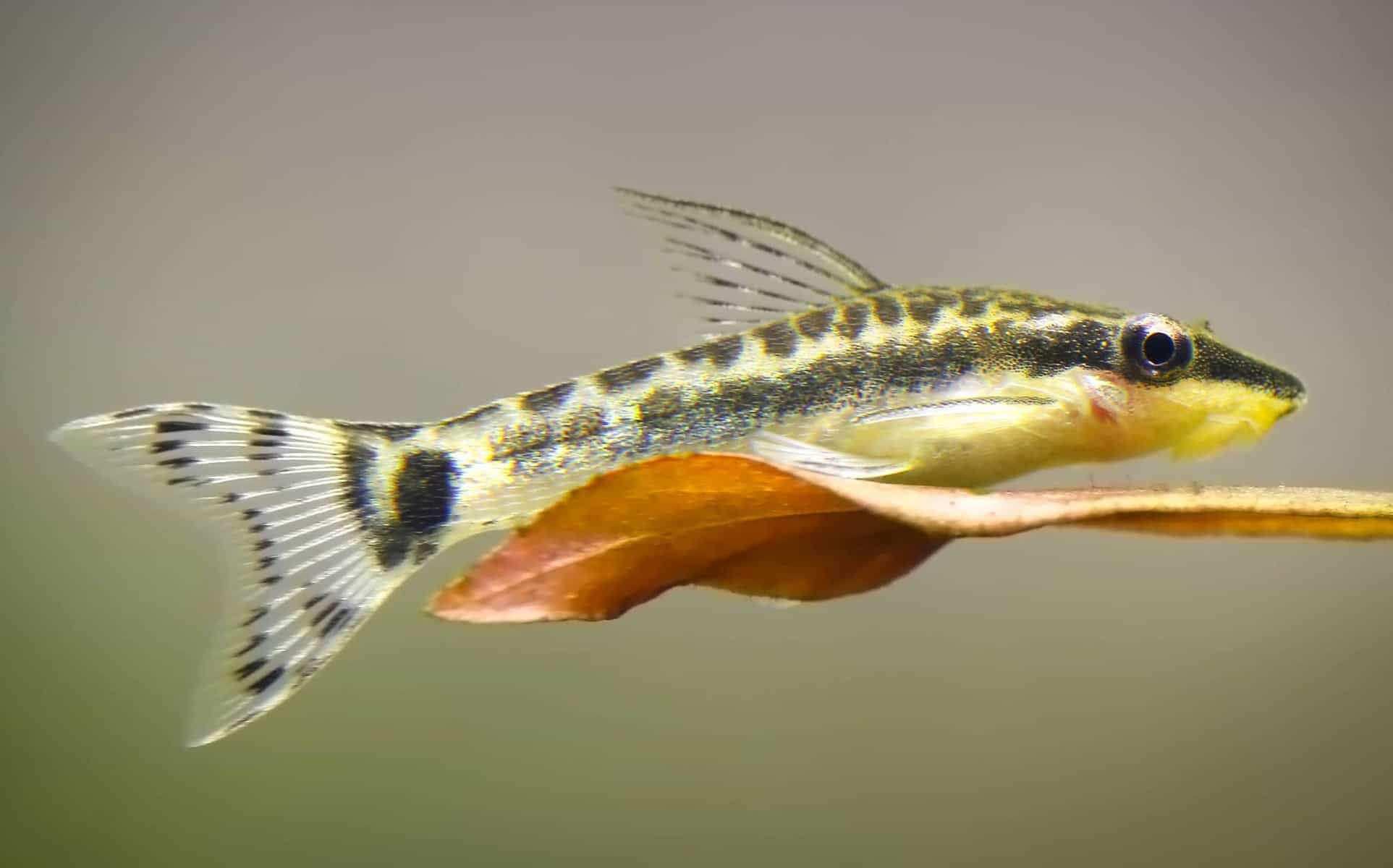
An all-fourth dimension algae-eating favorite and really on the listing of best algae eaters, Otocinclus catfish are one of the tinier catfish species available in the aquarium trade and can be kept in tanks of 15.v″/40cm and up. Their small size doesn't brand them easy or suitable for beginners, though. They're really a chip controversial due to their fragility and high death rate.
If yous want to proceed Otocinclus in your aquarium make sure it's fully cycled and, most chiefly, stable. Provide plenty of hiding places in the form of plants, rocks and forest and get a group of at least five fish (preferably more). Tankmate-wise, go for but the calmest species. Pocket-size schooling fish, shrimp and other peaceful catfish similar Corydoras can work well.
Yous can find a full Otocinclus caresheet containing everything you need to know about this tiny catfish here.
Glass catfish (Kryptopterus vitreolus)
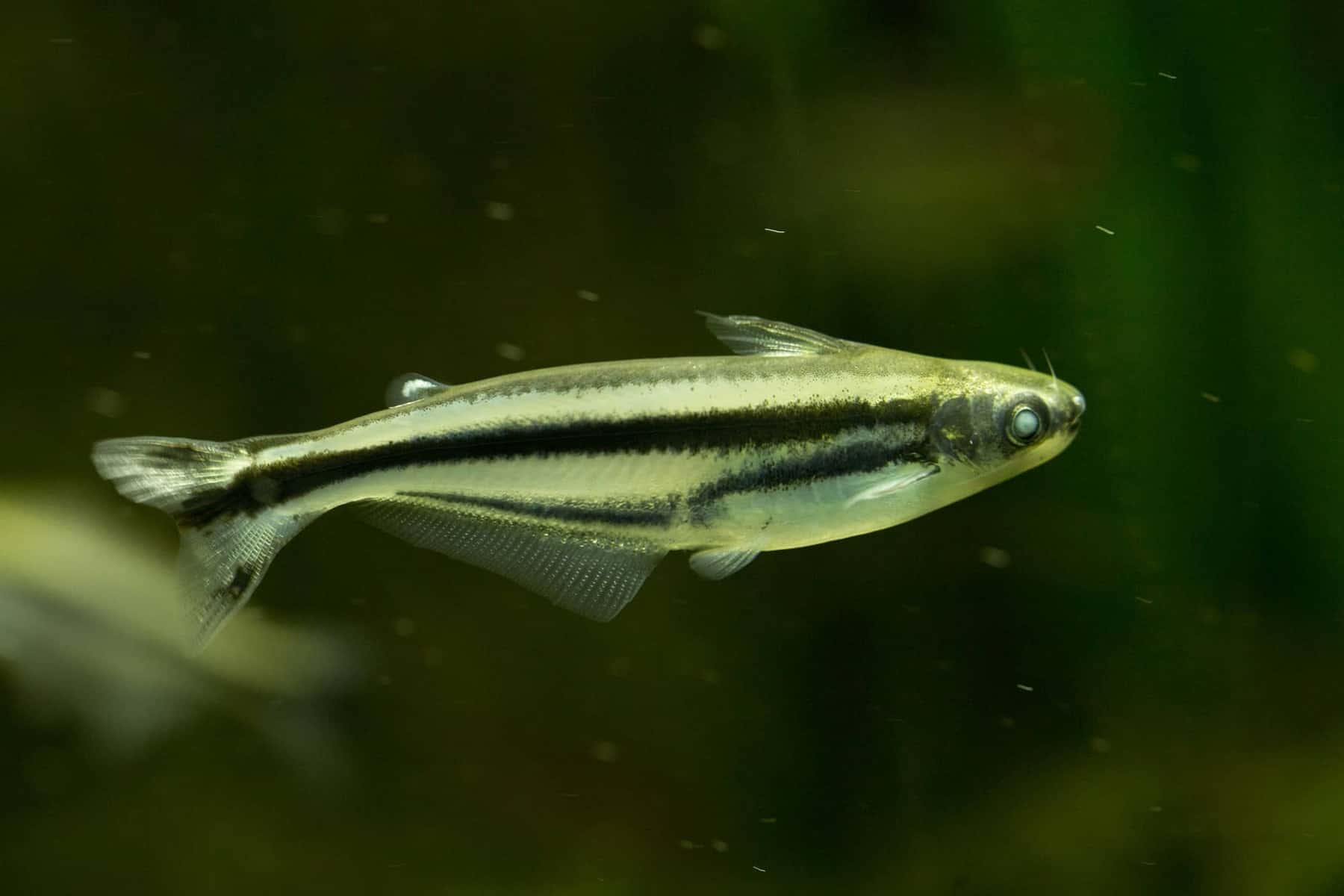
Glass catfish are another strange looking catfish species. They are translucent aside from a footling chip of pigmentation on the head, which means the inner organs are visible. Naturally found in blackwater habitats in Thailand they prefer a heavily planted setup with stained water, which can exist accomplished by calculation Indian almond leaves.
Continue glass catfish in schools of at to the lowest degree five in an aquarium of at to the lowest degree effectually twoscore″/100cm, because although they are one of the smaller members of their genus they tin can still grow to a size of around 2.five inch (~6.5cm). Due to their relatively inactive and peaceful nature, it'southward not a good idea to combine them with very active or aggressive tankmates.
Note:Kryptopterus vitreolus is often mislabeled equally Kryptopteris bicirrhis or minor. However, these are much rarer in the aquarium trade. Kryptopteris bicirrhis reaches a larger size and lacks the completely translucent body.
Bristlenose/bushynose catfish (Ancistrus)
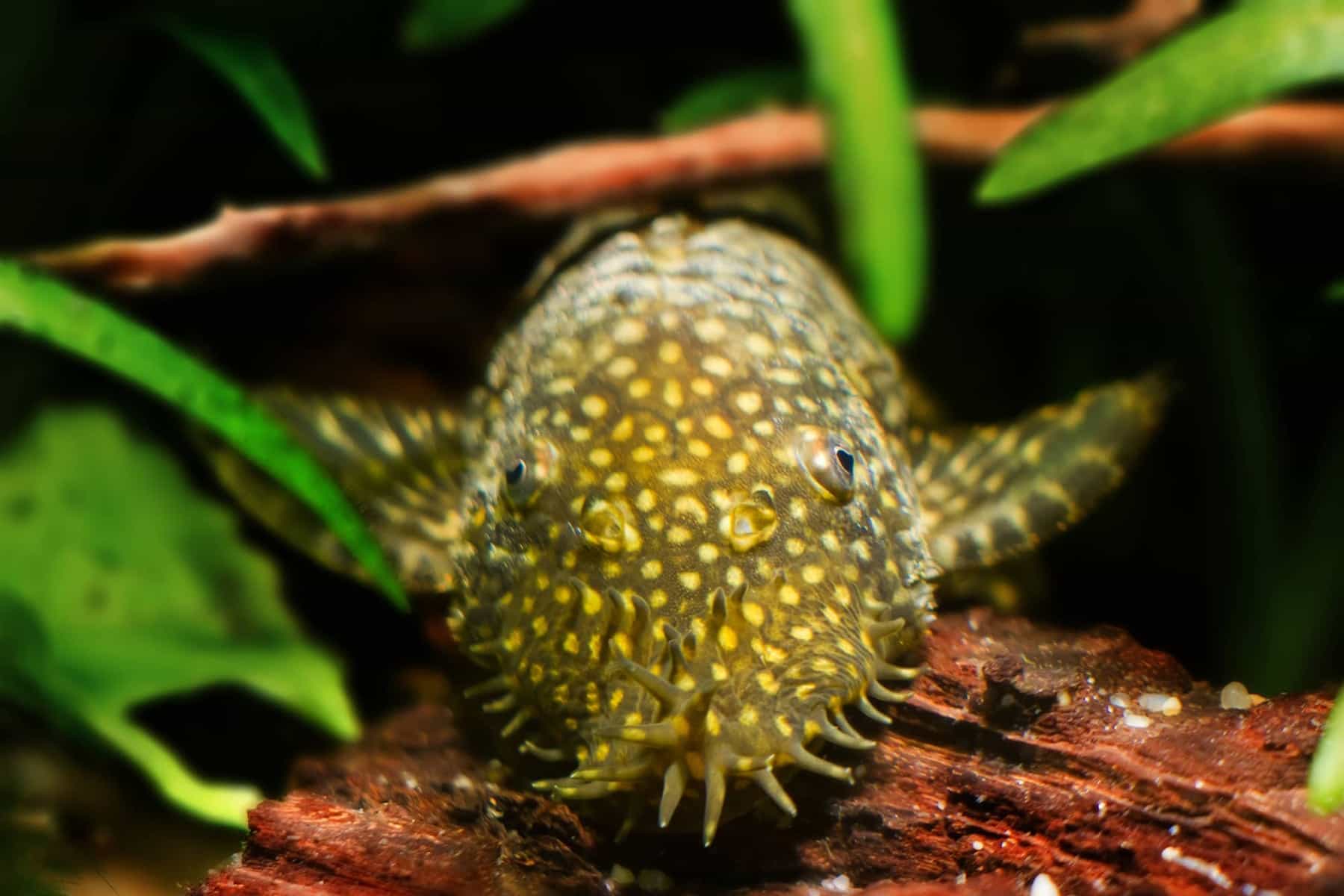
The genus Ancistrus, with Ancistrus cf. cirrhosus and dolichopterus probably being the virtually popular, is collectively known as bristlenose or bushynose catfish. The common proper noun is derived from the bushy facial growths mature males display.
All Ancistrus are mainly herbivores and can be fed a nutrition of algae pellets and blanched vegetables similar zucchini. They will also happily munch on poly peptide-based fish foods. They are a great addition to peaceful community aquariums of at least around 31.5″/80cm, although tank size obviously depends on the size of the detail Ancistrus variety you lot stop upwardly going for. Be sure to add plenty of hiding places.
Ancistrus are cavern breeders and, if provided with the correct blazon of surroundings and spawning sites, should breed easily. A fun projection!
Pictus catfish (Pimelodus pictus)
Their extremely active nature, larger size (reaching up to 6 inches/~15cm), predatory tendencies and shoaling nature make pictus catfish unsuitable for just any regular community aquarium. Nonetheless, this is no reason not to consider them. They are a real eyecatcher and a joy to watch.
Although pictus catfish are sometimes considered a solitary species, they are all-time kept in groups of at least five if y'all want them to feel at ease. For a group this size, an aquarium of at least 51″/130cm is a good place to beginning. Become for tough, fast tankmates: anything that fits into the pictus' mouth will inevitably terminate upward in there. The Ancistrus catfish discussed above could be suitable, equally are larger schooling fish.
Every bit can be seen in the video below, pictus catfish have a voracious appetite. A diet consisting of sinking wafers and plenty of frozen and live foods should work well.
Asian stone catfish (Hara jerdoni)
Hara jerdoni, besides known as Asian stone catfish, are a tiny catfish species that is as well found on the list of nano fish for small tanks. Due to their size and low activity level an aquarium as small as thirteen.5″/35cm can be enough to sustain these fish. They are slow eaters and easily outcompeted by faster tankmates, which means a very low-activity community is probably the best choice. In pocket-sized tanks, effort sticking to simply some (dwarf) shrimp equally tankmates.
Hara jerdoni is non a very popular species in the aquarium hobby every bit of now and then definitive info about them is even so scarce, but a group of at to the lowest degree 3-four fish seems preferable. Feed a high-protein diet consisting of frozen and possibly small live foods.
South American bumblebee catfish (Microglanis iheringi, Microglanis poecilus)
Not to exist dislocated with Pseudomystus siamensis, which is also often referred to as "bumblebee catfish" or "Asian bumblebee catfish" but grows much larger. The S American bumblebee catfish reaches a size of effectually ii.8 inches (~7cm) and is therefore suitable for medium sized aquariums.
South American bumblebee catfish can be kept in groups and combined with almost community fish that capeesh similar water values, though exist careful with smaller tankmates. Despite their peaceful nature these are even so catfish that will gladly consume anything they tin catch. A setup with plenty of hiding places is preferred, as this species loves to hide by wedging itself into any scissure it tin can discover. Go for coconut hides, rocks and plants that don't heed a relatively dimly lit environment, like Coffee fern.
Catfish to avoid
Although the list of worst beginner fish simply features one catfish, some of the species for sale in aquarium stores are really admittedly unsuitable for beginners and sometimes won't piece of work in most home aquariums altogether.
Shovelnose catfish (upward to 40 inches/ane metre), red-tailed catfish (easily over 50 inches/120cm), common Plecostomus catfish (over 20 inches/50 cm) and other large and in most cases very aggressive catfish species are plainly best avoided unless you're willing to become for the largest aquariums or fifty-fifty 1,000+ gallon ponds. These are sold every bit small juveniles that seem perfectly suitable for normal setups in the beginning, so research any and all fish before you buy!
If y'all accept any more questions almost the catfish on this list or want to share your own experiences, don't hesitate to leave a comment below!
Source: https://www.aquariadise.com/8-aquarium-catfish-for-community-tanks/
Posted by: wallacemough1944.blogspot.com


0 Response to "Can I Keep A Catfish In A 6.5 Gallon Tank"
Post a Comment